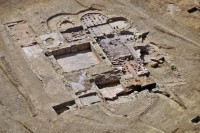 A preventative excavation of a site in the village of Langrolay-sur-Rance near Dinan in Brittany, northwestern France, has unearthed a huge Gallo-Roman villa. Archaeologists from France’s National Institute for Preventative Archaeology (INRAP) began excavating the 2.3 hectare site, the future location of a subdivision, in July 2016. They discovered multiple structures arranged in a u-shape around a central courtyard with colonnaded galleries on three sides. This was the pars urbana (the residential section) of a great villa and this section alone covered 1,500 square meters (16,000 square feet).
A preventative excavation of a site in the village of Langrolay-sur-Rance near Dinan in Brittany, northwestern France, has unearthed a huge Gallo-Roman villa. Archaeologists from France’s National Institute for Preventative Archaeology (INRAP) began excavating the 2.3 hectare site, the future location of a subdivision, in July 2016. They discovered multiple structures arranged in a u-shape around a central courtyard with colonnaded galleries on three sides. This was the pars urbana (the residential section) of a great villa and this section alone covered 1,500 square meters (16,000 square feet).
The main part of the house was built on a plateau with a beautiful view of the Rance river. The secondary structure faced south and was constantly flooded by sunlight. The third structure may have been used as stable. The courtyard and areas surrounding the buildings were landscaped gardens. Coins found at the villa indicate it was originally constructed in the 1st century A.D., it was altered and expanded over the years and was in use at least through the 4th century.
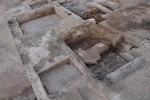 The most impressive testament to how exceptionally luxurious this villa was is its personal bath complex. At more than 400 square meters (4,300 square feet), it included a shallow foot bath, a warm pool, a cool pool, and a large caldarium, the hottest room in the complex, that had both a hot tub and a sauna. Bathers would start out with the foot bath, then take a dip in the cold and warm pools. Once washed, they’d move on to the caldarium to work up a proper sweat. They’d wash again and get a massage in the warm room and finish with a pore-closing cold bath. The private homes of the rich often had bathing facilities, but such a large, complex one is rare.
The most impressive testament to how exceptionally luxurious this villa was is its personal bath complex. At more than 400 square meters (4,300 square feet), it included a shallow foot bath, a warm pool, a cool pool, and a large caldarium, the hottest room in the complex, that had both a hot tub and a sauna. Bathers would start out with the foot bath, then take a dip in the cold and warm pools. Once washed, they’d move on to the caldarium to work up a proper sweat. They’d wash again and get a massage in the warm room and finish with a pore-closing cold bath. The private homes of the rich often had bathing facilities, but such a large, complex one is rare.
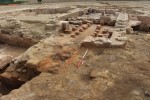 Unlike the rest of the villa of which only the foundations and patches of concrete floors have survived, walls and floors of the bath complex are extant, including the tile stacks that raised the floor to allow the hypocaust system to heat the warm rooms. The walls were decorated with frescoes inlaid with shell, a characteristic Armorican style developed beginning in the 3rd century A.D. White, red,
Unlike the rest of the villa of which only the foundations and patches of concrete floors have survived, walls and floors of the bath complex are extant, including the tile stacks that raised the floor to allow the hypocaust system to heat the warm rooms. The walls were decorated with frescoes inlaid with shell, a characteristic Armorican style developed beginning in the 3rd century A.D. White, red, 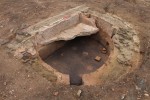 green, blue or yellow shells of different species would be embedded in fresh mortar to create intricate designs. Because the mortar had to be wet when the shells were applied, many workers applied themselves to the task at the same time. A few fragments of decorative shell have been found at 23 ancient sites in western France, but only two of those were large enough to make it possible to piece together the pattern of decoration. The remains discovered at Langrolay are unprecedented in their size and quality.
green, blue or yellow shells of different species would be embedded in fresh mortar to create intricate designs. Because the mortar had to be wet when the shells were applied, many workers applied themselves to the task at the same time. A few fragments of decorative shell have been found at 23 ancient sites in western France, but only two of those were large enough to make it possible to piece together the pattern of decoration. The remains discovered at Langrolay are unprecedented in their size and quality.
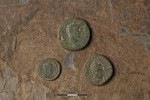 Such a massive villa was likely the country home of a very rich and politically prominent noble family, probably of the Curiosolitae people. The nearby village of Corseul is believed to have been the capital of the Curiosolitae (the naming of the main town after the people was a Gallic convention) and remains of the ancient Roman city of Fanum Martis have been discovered there. The villa would have been an easily accessible half-day’s ride from the city about eight miles away. It could also have been reached by river, a short boat trip up the Rance.
Such a massive villa was likely the country home of a very rich and politically prominent noble family, probably of the Curiosolitae people. The nearby village of Corseul is believed to have been the capital of the Curiosolitae (the naming of the main town after the people was a Gallic convention) and remains of the ancient Roman city of Fanum Martis have been discovered there. The villa would have been an easily accessible half-day’s ride from the city about eight miles away. It could also have been reached by river, a short boat trip up the Rance.
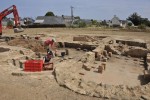 The excavation was originally scheduled to be finished by the end of November, with whatever could be salvaged removed from the site and the rest destroyed to make way for the undoubtedly unworthy subdivision. The discovery caused a sensation, however. When it was opened to the public on September 17th and 18th, more than 6,000 people visited it. The construction plan is going to be revised, as the city council voted to conserve the thermal baths in situ. For now, the site will be reburied for its own protection.
The excavation was originally scheduled to be finished by the end of November, with whatever could be salvaged removed from the site and the rest destroyed to make way for the undoubtedly unworthy subdivision. The discovery caused a sensation, however. When it was opened to the public on September 17th and 18th, more than 6,000 people visited it. The construction plan is going to be revised, as the city council voted to conserve the thermal baths in situ. For now, the site will be reburied for its own protection.
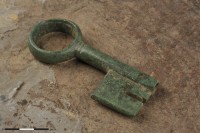
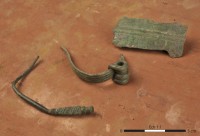
Fabulous discovery. !!
6000 is a pretty good turnout.
The Gallic peoples of modern Brittany: This map shows Condate Riedonum (Rennes, on the map referred to as ‘Rhoazon’), the Coriosolites or ‘Koriosolited’ with Fanum Martis (Corseul, ‘Kersaout’) and Aletum (Saint-Malo, ‘Alot’).
Steles found in Rennes mention Titus Flavius Postuminus. He took charge over all the public affairs in the Civitas Riedonum (Condate), was twice duumvir (who were the other ones ?) and was also priest for life for Mars / Mullo (with links to Fanum Martis ?).
The 4th century, a little later, must have been a turbulent one.
Fascinating. Would have loved to see photos of the shell decoration too.